Themed collection Spotlight Collection: Inorganic Molecular Electronics

Spotlight collection on inorganic molecular electronics
Guest Editors Cláudio N. Verani and Paul J. Low introduce the Spotlight Collection, “Inorganic Molecular Electronics”.

Dalton Trans., 2024,53, 1897-1897
https://doi.org/10.1039/D4DT90009J
Molecular rectifiers based on five-coordinate iron(III)-containing surfactants
The state-of-the-art of metallorganic-based molecular rectification is reviewed with an emphasis on asymmetric five-coordinate FeIII-containing surfactants in electrode|LB film|electrode assemblies.
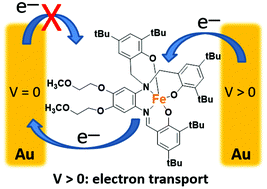
Dalton Trans., 2018,47, 14153-14168
https://doi.org/10.1039/C8DT02891E
Metal bis(acetylide) complex molecular wires: concepts and design strategies
This Perspective highlights relationships between chemical features of metal bis(acetylide) complexes and their electrical response in a molecular junction.
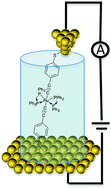
Dalton Trans., 2018,47, 14125-14138
https://doi.org/10.1039/C8DT02103A
Coordination polymers: a promising candidate for photo-responsive electronic device application
This study emphasizes recent advances in the designing of coordination polymers for photo-responsive electronic device applications in regard to crystal engineering aspects and structure–property relationship.

Dalton Trans., 2023,52, 17084-17098
https://doi.org/10.1039/D3DT02768F
STM studies on porphyrins and phthalocyanines at the liquid/solid interface for molecular-scale electronics
Scanning tunneling microscopy (STM) represents a very powerful tool to correlate the charge transport behaviours of porphyrins and phthalocyanines with ultrahigh resolution imaging.

Dalton Trans., 2023,52, 11017-11024
https://doi.org/10.1039/D3DT01518A
Electrically conductive 1D coordination polymers: design strategies and controlling factors
This frontier article highlights the design strategy and controlling factors that affect the electrical conductivity of 1D coordination polymers.

Dalton Trans., 2021,50, 29-38
https://doi.org/10.1039/D0DT03222K
Nanostructured surfaces from ligand-protected metal nanoparticles
Using ligand-protected nanoparticles to create low-dimensional nanostructures on the surfaces represents a facile and efficient approach to fabricate nanostructured surfaces.
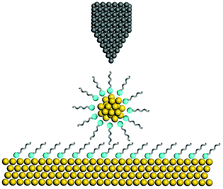
Dalton Trans., 2020,49, 14314-14319
https://doi.org/10.1039/D0DT02822C
Phosphindole fused pyrrolo[3,2-b]pyrroles: a new single-molecule junction for charge transport
A new family of phosphindole fused ladder-type heteroacenes with a pyrrolo[3,2-b]pyrrole core were synthesized and characterized, which show good luminescence efficiency, high thermostability and tunable conductance.
![Graphical abstract: Phosphindole fused pyrrolo[3,2-b]pyrroles: a new single-molecule junction for charge transport](/en/Image/Get?imageInfo.ImageType=GA&imageInfo.ImageIdentifier.ManuscriptID=C9DT01299K&imageInfo.ImageIdentifier.Year=2019)
Dalton Trans., 2019,48, 6347-6352
https://doi.org/10.1039/C9DT01299K
Conductance and assembly of quasi-1D coordination chain molecular junctions with triazole derivatives
Binding site electron density in σ-type molecular orbitals is the decisive factor in the in situ assembly of quasi-1D coordination chains using triazole (Tr) isomer ligands in molecular junctions.

Dalton Trans., 2024,53, 10453-10461
https://doi.org/10.1039/D4DT01085J
A convenient synthesis of ferrocene-(ethynylphenyl)thioacetates
A protecting-group strategy can be used to synthesise symmetrical, asymmetrical and multi-ferrocenyl molecular wires, terminated with thioacetates – rare molecules with significant potential in the fabrication of molecular nanoelectronics.

Dalton Trans., 2023,52, 16465-16471
https://doi.org/10.1039/D3DT02954A
Influence of crystal structure and composition on optical and electronic properties of pyridinium-based bismuth iodide complexes
2D structure of bismuth iodide brakes into fragments of different dimensionality and geometry upon reaction with substituted pyridinium iodides. The main factor determining the structure of the product is dipole moment of pyridinium cation.

Dalton Trans., 2023,52, 14649-14662
https://doi.org/10.1039/D3DT02910G
Probing the effect of nitro-substituents in the modulation of LUMO energies for directional electron transport through 4d6 ruthenium(II)-based metallosurfactants
Nitro groups intended to modulate the energy of Frontier molecular orbitals were installed onto terpyridine- and phenanthroline-based RuII metallosurfactants aiming to match the Fermi levels of electrodes for charge transport in Au|LB|Au junctions.

Dalton Trans., 2023,52, 12423-12435
https://doi.org/10.1039/D3DT01797D
Methyldisulfide groups enable the direct connection of air-stable metal bis(terpyridine) complexes to gold surfaces
A new ligand comprising directly-connected disulfide-based anchors provides access to air-stable metal bis(terpyridine) complexes for the functionalization of metal surfaces.
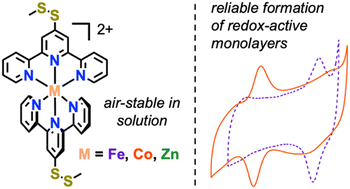
Dalton Trans., 2023,52, 7836-7842
https://doi.org/10.1039/D3DT00955F
Electron transport through a (terpyridine)ruthenium metallo-surfactant containing a redox-active aminocatechol derivative
A ruthenium-containing metallosurfactant [Ru(terpy-X)(SQ)Cl]PF6 displays extensive orbital mixing, and allows a low-lying LUMO primarily associated with the SQ ligand to engage in directional electron transport in Au|LB 1|Au junctions.
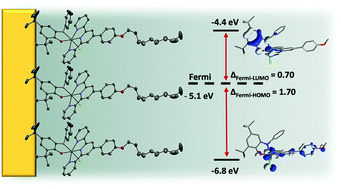
Dalton Trans., 2022,51, 8425-8436
https://doi.org/10.1039/D2DT00938B
Computational study of the staircase molecular conductivity of polyoxovanadates adsorbed on Au(111)
This computational study presents the molecular conduction properties of polyoxovanadates V6O19 (Lindqvist-type) and V18O42, as possible successors of the materials currently in use in complementary metal–oxide semiconductor (CMOS) technology.

Dalton Trans., 2021,50, 5540-5551
https://doi.org/10.1039/D1DT00731A
Mix and (Mis)match: further studies of the electronic structure and mixed-valence characteristics of 1,4-diethynylbenzene-bridged bimetallic complexes
Infra-red spectroelectrochemical studies of [{Cp′(CO)xM′}(μ-C![[triple bond, length as m-dash]](https://www.rsc.org/images/entities/char_e002.gif) CC6H4C
CC6H4C![[triple bond, length as m-dash]](https://www.rsc.org/images/entities/char_e002.gif) C){M(PP)Cp′}]n+ [n = 0, 1] illustrate limited ground-state interactions in these donor–acceptor compounds and the localised nature of the one-electron redox processes.
C){M(PP)Cp′}]n+ [n = 0, 1] illustrate limited ground-state interactions in these donor–acceptor compounds and the localised nature of the one-electron redox processes.
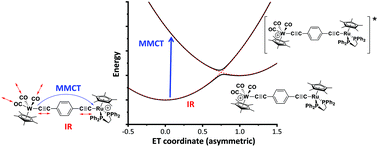
Dalton Trans., 2020,49, 9835-9848
https://doi.org/10.1039/D0DT01794A
Redox-driven porphyrin based systems for new luminescent molecular switches
This work explores the possibility of controlling the fluorescence of porphyrins via oxidation of a ruthenium acetylide unit. The modulation depends on the nature of the porphyrin unit(s).

Dalton Trans., 2018,47, 8364-8374
https://doi.org/10.1039/C8DT01493K
Observation of current rectification by a new asymmetric iron(III) surfactant in a eutectic GaIn|LB monolayer|Au sandwich
This surfactant, as a Langmuir–Blodgett monolayer on Au, has electrical rectification ratios from 25 to 300 at 1 Volt (the coordinating Ns are the electron donors, Fe(III) is the electron acceptor). The red arrow shows the direction of preferred electron current.
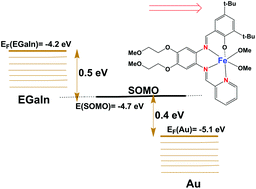
Dalton Trans., 2018,47, 6344-6350
https://doi.org/10.1039/C8DT00562A
About this collection
The concept of molecular electronics was inspired by the desire to harness the electrical properties of one or more molecules trapped between macroscopic electrodes under bias to perform functions analogous to those solid-state electronic components at an ultra-miniaturized scale. Progress in the field ebbed and flowed from the 1950s to 2000s as concepts, theories and experiments met with frustrations arising from the technical challenges of achieving these goals. With the advent of laboratory methods for the construction of electrode-molecule-electrode junctions, molecular electronics has emerged as a genuine field of endeavor, with ambitions and applications that far exceed the initial premise. This Spotlight Collection on Inorganic Molecular Electronics aims to highlight recent developments in the application of the structural, optical, electronic and magnetic properties of inorganic complexes and organometallic complexes in molecular electronics, and the theories, synthetic, analytical, and physical approaches that deliver unique molecular systems with customized and controlled properties.
Current research with metal complexes in junctions emphasizes new concepts and strategies for electron transport in junctions, the design of logic devices, and the development of molecular components such as wires, memory elements, transistors, memristors, rectifiers, or on/off switches. Beyond electronics, molecular junctions attract interest as tools for the development of spintronics, single-molecule sensing systems, thermoelectrics, and an increasingly wide array of materials science applications.
This collection is guest edited by Dalton Transactions Advisory Board member Prof. Cláudio Verani (Wayne State University, USA), and Prof. Paul Low (University of Western Australia, Australia).
Articles will be added to this themed collection as soon as possible after they are published. Please return to this page frequently to see the collection grow.
If you would like to contribute an article to this collection, please contact the Editorial Office at dalton-rsc@rsc.org with your proposed topic.